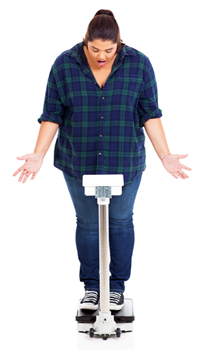When people reach their limit of weighing too much, they often search for a “magic pill” to help them lose weight. They may even get some motivation to start a diet… and maybe even some regular exercise.
But the real question is… how you are measuring success from your efforts? Is the weight scale your only way of knowing whether your weight loss plan is working?
Seems simple enough. You step on the scale and notice your weight is “out of bounds” by the number it registers. You get a plan of action and start. A few days later you step on the scale and expect to see “something” in the way of a lower number… but you don’t. What went wrong?
Soon you realize that the weight loss game isn’t straight forward (or a straight line) like you thought it would be. But you persist.
A few more days later and after you step on the scale, you notice a slight reduction in “the number”… real slight, like a third of a pound.
Then it really hits you: this is going to be a tougher battle than you thought.
You Can’t See What’s Going On Below Your Skin
When you step on a regular weight scale and are looking to see how your weight loss is doing, keep in mind that you are seeing your “total weight” number. That number is actually the combined sum of two weights: Your Lean Mass Weight AND your Fat Weight.
Your Fat Weight is, well, how many pounds of fat your body is carrying around. But your Lean Mass Weight is further subdivided into all your water weight, the weight of your organs and bones, and all the weight of your muscles. The key variable in your Lean Mass Weight is your muscle weight.

It’s likely that before you started your plan to lose weight, you probably didn’t do much in the way of exercise that challenges your muscles. If this is true, then it’s also likely that you’ve lost a certain amount of muscle over the past years due to non-use or “disuse atrophy”.
While this occurs slowly under your skin and not necessarily obvious to you in the mirror, it is similar to the phenomenon that occurs after you take a healed broken arm out of its cast – smaller and weaker.
Weight Loss VS. Fat Loss
Your REAL GOAL in any weight loss process should not be to just to reduce weight, but to REDUCE BODY FAT. If you’re weighing yourself often, your overall weight loss numbers will not necessarily reflect your “fat loss”.
In addition, your regular scale weight can fluctuate from day-to-day and week to week because of changes in body water due to hormonal changes, body hydration and whether you drink enough water each day, recovery from a large bountiful weekend, and even hidden sugar/salt in foods you’ve eaten the past 48 hours, etc.
Since how much body fat you’ve lost can only accurately be determined by having a Body Composition Analysis using a specialized medical-grade Body Composition Assessment System and a measuring tape, then how do you know if your progress is moving in the right direction if you don’t have access to this technology?
This simplest and easiest way: By how your clothes begin to fit.

If you find that even though your overall weight is slow to change BUT your clothes are fitting looser around the areas you tend to accumulate fat (waist, hips, thighs, and even the chest and arms) and you’re maybe even down in a size or two, then things are happening in the positive direction: you’re losing fat and excess water weight.
Other Factors That Matter
Here are some additional points to keep in mind when trying to assess your weight loss AND fat loss progress when weighing yourself on a regular weight scale. Many of these points became “expected principles” as we worked with thousands of real clients over 20 years in our Metabolic Weight Loss & Exercise Center:
- Exercise, particularly that which challenges your muscles like strength-training, will increase muscle tissue volume and bone density, and thus adding good and healthy weight to your body. Just the mere fact that muscle weighs nearly three times as much as the same volume of fat can even show an initial weight gain on the scale while you are actually losing excess body fat.
- In general, exercise increases total body water through an increase in plasma volume and can tend to negate total weight loss even though fat loss is occurring.
- One pound of fat occupies a much larger space in your body than one pound of lean muscle tissue, so initially, there may be a significant change in body dimensions with little change in body weight.
- If you are performing any type of resistance exercise (which you should), it positively increases your resting metabolic rate (RMR) through an increase in active muscle mass and partially by increasing the release of fatty acids from fat stores.
- Weight loss through diet-only programs always includes the loss of non-fat tissue (muscle). In extreme cases, up to 70% of the total weight loss can be from lean muscle tissue.
- If you have a previous diet history of losing weight and putting it back on, you will tend to take longer to lose body fat and thus “real weight”. The reason for this slow-to-start phenomenon is because your metabolism is used to a deprivation diet, which can dramatically lower one’s metabolism. This type of situation often warrants that you eat a higher calorie level initially to raise your metabolism and help support the recovery with a metabolism-based supplement formula like Metabolism DAY.
- From working with thousands of clients in our Metabolic Weight Loss & Exercise Center, we found that clients usually lose inches before they ever lose a pound, but fit differently in their clothes and even drop a dress/pant size without noticing any initial changes on the weight scale.
- Weight loss results can show up differently for different people. We have seen some will experience noticeable weight/fat results in the first 4-8 weeks, while others not until the third month.
- And finally, some people lose weight/fat steadily while others lose at a very slow rate, usually dependent upon their current metabolism’s efficiency and prior dieting history. And some people can lose a fair amount of weight in the beginning but then hit weight loss plateaus until other “pending factors” have been resolved.
While losing weight successfully can seem like a “moving target”, the key is to persevere even when the scale doesn’t seem to budge. Just keep in mind that the BEST way to know if you’re headed in the right direction, even when the scale seems “stuck”, is to take note how your clothes begin to fit and whether you’re able to drop a jean size from time to time. Good luck!
Rich Farina, M.S. is a Metabolic Health and Conditioning Specialist with over 30 years of experience helping thousands of individuals lose weight, rebuild their metabolisms, and improve their health in his Metabolic Testing & Weight Loss Centers.
He holds both Bachelor of Science and Master of Science degrees in Exercise Physiology and Public Health respectively and is a passionate advocate of using proven, scientific principles in his approach to exercise and nutrition.
He is a contributing author, professional speaker, and advisor on topics that include weight loss, human performance, and medical fitness.
He continues his deep-seated passion to help people improve their health and longevity through his own line of premium, all-natural nutritional supplements called Truthentics™. The Truthentics™ brand of nutritional supplements is specifically designed to help people compensate for nutritional deficiencies and bring their bodies back into balance.










